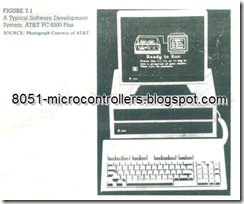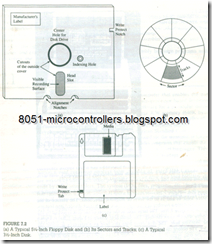7.1 MICROPROCESSOR-BASED SOFTWARE DEVELOPMENT SYSTEMS
A software development system is simply a computer that enables the user to write, modify, debug, and test programs. In a microprocessor-based development system, a microcomputer is used to develop software for a particular microprocessor. Generally, the microcomputer has a large R/W memory (640K bytes or higher), disk storage, and a video terminal with a typewriter-like keyboard. The keyboard enables the user to write programs in- alphanumeric (alphabet and number) characters, which are translated into American Standard Code for Information Interchange (ASCII) binary code; the keyboard (or the terminal) is known as ASCII keyboard (or terminal). The system includes programs that enable the user to develop software in either assembly language or high-level languages. This text will focus on developing programs in the Z80 assembly language.
Conceptually, this type of microcomputer is similar to a single-board microcomputer except that it has additional features that can assist in developing large’ programs. Programs are accessed and stored under a file name (title), and they are written by using such other programs as text editors and translated into binary code by using assemblers. The system (I/Os, files, programs, etc.) is managed by a program called the operating system. The various hardware and software features of a typical software development system are described in the next sections.
7.1.1 System Hardware and Storage Memory
Figure 7.1 shows a typical software development system; it includes an ASCII keyboard, a CRT terminal, an MPU board with R/W memory (around 640) and disk controllers, and two disk drives. The disk controller is an interfacing circuit through which the MPU can access a disk and provide Read/Write control signals. The disk drives have Read/Write elements that are responsible for reading and writing data on the disk. Two types of floppy disks are in use: 51/4-inch and 31/4 312inch. A 5V4-inch single-density disk can store about 90K bytes of data; the storage capacity can be doubled by using double-density disks, and quadrupled (to 360K) by using both sides of the disks. A high-density 5V4-inch disk can store 1.2M bytes. A 3V2-inch double-sided double-density disk stores 740K bytes, and high-
density stores 1.44M bytes. In addition, most systems nowadays have a permanently installed hard disk with memory capacity of 10M to 120M bytes.
FLOPPY DISK
A floppy disk-Figure 7.2(a)-is made of a thin magnetic material (iron oxide) that can store logic 0s and 1s in the form of magnetic directions. The surface of the disk is divided into a number of concentric tracks, each track divided into sectors, as shown in Figure 7.2(b). The large hole in the center of the disk is locked by the disk drive when it spins the disk. The small hole shown in Figure 7.2(a) is known as the indexing hole. The disk drive uses this hole as a reference to count the sectors. The oblong cutout, called the head slot, is the reading/recording segment; this is the only segment of the surface that comes in contact with the R/W head. At the edge of the disk, near the head slot, is a notch called the Write Protect notch. If this notch is covered, data cannot be written on the disk; the disk is then "Write Protected." Figure 7.2(c) shows a typical 3 1/2 -inch disk.
Each sector and track is assigned a binary address by using a program (FORMAT); this is called formatting a disk. The MPU can access any information on the disk with the sector and the track addresses; however, the access is semi-
random. To go from one track to another, the access is random. Once the track is found, the system waits for the index hold and then locates the sector serially by counting the sectors. Once data bytes are located, they are transferred to the system’s R/W memory. These data transfer functions between a floppy disk and the system are performed by the disk controller and controlled by the operating system, also known as the Disk Operating System (DOS), described in Section 7.12.
HARD DISK
Another type of storage memory used with computers is called a hard disk or Winchester disk. The hard disk is similar to the floppy disk except that the magnetic material is coated on a rigid aluminum base and enclosed in a sealed container. While it is highly precise and reliable, the hard disk requires sophisticated controller circuitry. However, its storage capacity is quite large. Hard disks are available in various sizes; 31/2 -inch, 51/4-inch, and 14-inch. Storage capacity can range from several megabytes to several gigabytes.

